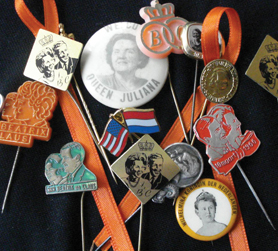Dutch House of Orange-Nassau’s Relationship with New York Described
“Royal Roots Revisited: Saluting the Dutch House of Orange-Nassau” explores Netherlandish monarchs’ relationship with the New World since the early 17th Century.
Part of New York State’s quadricentennial celebration of explorer Henry Hudson’s 1609 arrival in Manhattan, the historic Vander Ende-Onderdonk House’s exhibition (August 1-November 15, 2009) features more than 125 rare coins, vessels, photographs and related ephemera. Dutch historian Matthew Jensen has been ably supported by seasoned curators Arthur Kirmss and Ellen Brody-Kirmss, archivist Meghan Harkins, gallerist John Ogren and art historian Stan Parchin.
The exhibition coincides with the September 2009 visit to New York of the Netherlands’ Crown Prince Willem-Alexander and Crown Princess Maxima for the 400th commemoration of Henry Hudson’s landing in the New World.
William the Silent to Queen Beatrix
Honoring persons and events in the Dutch royal family’s history has a long tradition in the Netherlands. In 1609, navigator Henry Hudson (1564-1611) sailed up the waterway that would eventually bear his name. The explorer called it “de Maurits Rivier” after the reigning prince of Orange-Nassau. Maurits (r. 1584-1625) succeeded William the Silent (r. 1579-1584), founder of the Dutch royal house. The dynasty’s members have continued to play an important role in Holland’s affairs of state since before New Amsterdam’s establishment in 1625.
Royal Roots Revisited: Saluting the Dutch House of Orange-Nassau links the present monarchy to the founding sovereigns of the Dutch Republic. The coinage, decorative arts and photographs on display mark important occasions, among them the birth of William the Silent (1533) and the inauguration of the Kingdom of the Netherlands (1813).
Coins, Silverware, Ceramics and Commemorative Works
Objects of historical and cultural importance on view include:
• rare examples of Dutch currency and ceramic vessels dating from before the founding of New Amsterdam to the reign of Queen Beatrix (r. 1980-present);
• a splendid 14-piece silver spoon set (1933) issued for the 400th anniversary of William the Silent’s birth; and
• an exquisite plate produced for the Netherlands Aid Society that commemorates the birth-in-exile of Princess Margriet in 1942.
Vintage Photographs of Dutch Royal Visits
The special bond between the Dutch royals and modern New York is emphasized by the presence of archival photographs that record past monarchs’ visits to the Empire State. Images of Princess Beatrix’s 1959 New York trip to celebrate the 350th anniversary of Hudson’s historic voyage are one of the exhibition’s highlights.
Vander Ende-Onderdonk House
Run by the Greater Ridgewood Historical Society, the Vander Ende-Onderdonk House is New York City’s oldest Dutch Colonial stone dwelling. Open to the public since 1982, the building, situated on land granted to its original owners by Peter Stuyvesant (ca. 1619-1672), lies directly on the Queens side of the county’s border with Brooklyn. Manhattan’s skyline can still be seen clearly from atop the enclosed acreage’s promontory. Landmarked in June 1996, the structure is easily recognized by its Dutch doors and double-hung windows with wooden shutters.
In addition to storing artifacts, local historical records and genealogical resources, the Vander Ende-Onderdonk House, funded by members and city agencies, mounts exhibitions that appeal to visitors of all ages. Recent popular offerings include: Cross Currencies: Making Money in Old New York (2006); Vernederlandsen: An Assimilated Anatomy by Denise Martinez (2006); and Just After the Battle: An Exhibit of the American Civil War (2007-08).
Reaching the Onderdonk House by public transportation is easy. Bus Q-54 stops two blocks from the landmark building at the intersection of Metropolitan and Flushing Avenues. Bus B-57 passes the historic house on Flushing Avenue. “L” subway line to Jefferson Street (Brooklyn) stop; proceed five blocks north along Flushing Avenue. On-street parking is plentiful and free-of-charge.
The Onderdonk House is operated by the Greater Ridgewood Historical Society, 1820 Flushing Avenue, Ridgewood, NY 11385. Telephone: (718) 456-1776.




